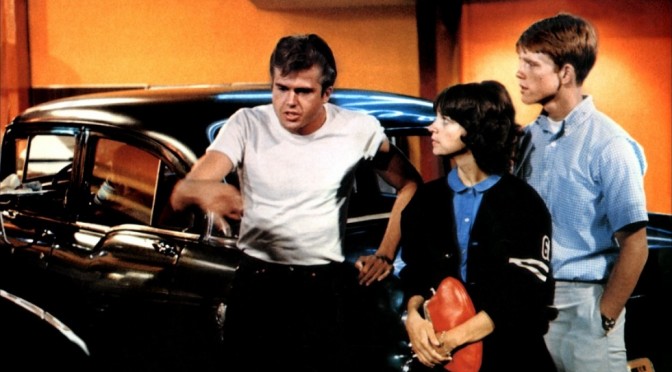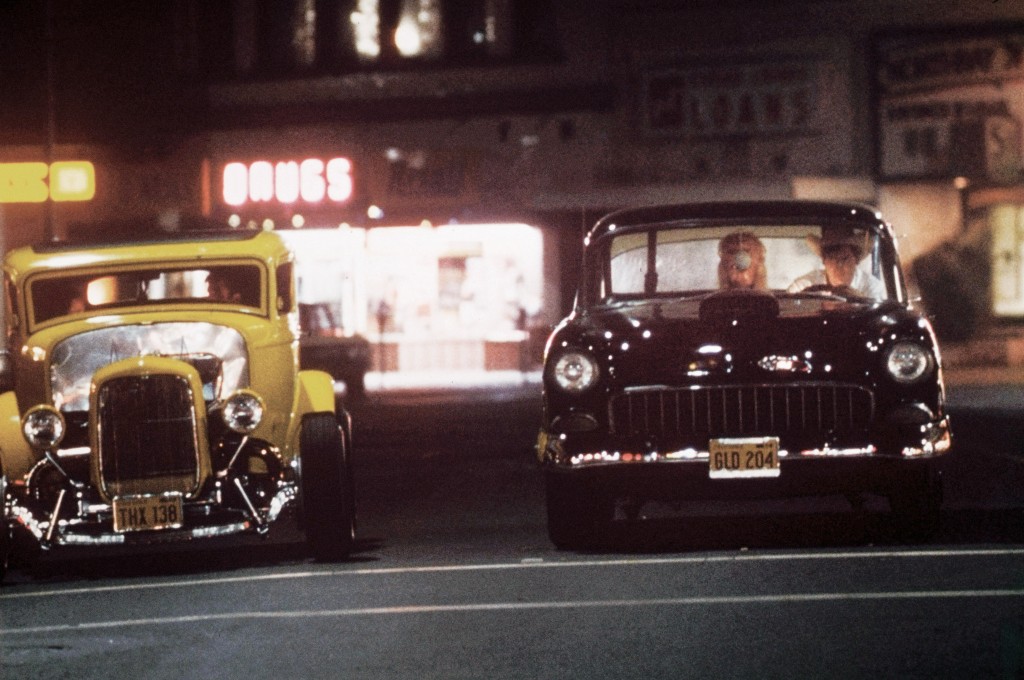This installment of Speed Week Plus is a little different. There are no chase scenes and there’s only one all-out street race (not the one in the clip at the bottom of this post, which was cut short by a red light). In fact, it’s not even action adventure, but more of a dramedy. Yet American Graffiti is such an iconic film for gearheads and speed freaks of the pre-Internet generations, it just can’t be left out.
I’ve often wondered about the title–what it was supposed to mean. The only way I could connect it with the film’s content was to imagine a yearbook of the high school class the main characters belonged to (which, I guess, would fit the Dragnet-style “where-are-they-now” overlays just before the final credits. And a yearbook is actually used in the trailer below). Then I discovered the original title was “Rock Radio is American Graffiti,” and all became clear.
The film is about “cruising culture” which was ubiquitous in postwar America, right up until the gas crunch in the early ’70s I guess. What united the entire car crazy generation was rock & roll. And regional subsections of that generation were connected usually by a single personality, in the form of a radio disk jockey. In this case it’s the mysterious and almost mystical Wolfman Jack. Not only does the original title augment this theme, but in the screenplay the very first shot was not supposed to be of Mel’s Drive-In, but of a car radio dial being tuned to XERB.
Film maker George Lucas (whose only other feature to date had been the box office flop THX1138) had grown up in that generation. This movie is essentially a cinematic reminiscence of his glory days between graduating high school and packing off to film school. Two of the main characters are loosely based on Lucas himself–Kurt the aimless intellectual and Toad the nerdy braggart). The lone rebel hero (who the TV show Happy Days caraciturized into somebody called “Fonzy”) John Milner, was partially based on Lucas’ film school buddy John Millius, who went on to become a director also, despite punching out one of his professors. Average all-American boy Steve Bollander was also caricaturized on Happy Days, into Richie Cunningham (both played by Ron Howard, who also went on to become a director). And remember that annoying actress from Happy Days spinoff Laverne & Shirley? No, not her, the other one, with the dark hair. She plays Steve’s girlfriend and is not annoying at all in the role. Actually she did a fine bit of acting.
This movie was a first in many ways. Imitators cranked out nostalgic flicks well into the ’80s, trying to hitch a ride on its coat tails. The bed of vintage pop music, sometimes even with a DJ chattering over and between, became the norm in Hollywood soundtracks, nearly putting film score composers out of business until, Ironically, Lucas’ Star Wars revolutionized the film industry again. How about ensemble casts with parallel converging plotlines? That’s nearly obligatory in comedy/dramas to this day.
Though left vague enough for any baby boomer to relate to, it’s pretty much agreed to that the story takes place in Modesto, California in 1962. On the last summer night–from sundown to sunup. Filmed just ten years after the period depicted, the simulation is done so well that even folks who were born after that era was lost forever can almost… almost “remember” those times while watching it.
I don’t know that I could effectively argue that this is an “important” film, but it certainly has had an impact on a lot of people. It can so immerse you in the milieu of postwar pre-Vietnam teenage cruising-to-rock-radio that you’ll feel a part of it even when watching it for the 45th time…then be saddened by the passing of a bygone era until you watch it again.
The possible next post for Speed Week Plus is also about a story that fuses cars with music–with a different approach, set in a different era, but with much homage to this very movie.



